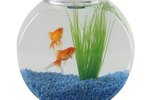
In the United States, aquarium antibiotics usually do not require a prescription, though in Britain you may need orders from a veterinarian. The antibiotic oxytetracycline can treat a wide variety of bacterial fish diseases. However, it also presents some drawbacks.
How It Works
Oxytetracycline belongs to the tetracycline family of antibiotics, originally derived from a fungus. Antibiotics in this family work by interfering with bacteria's ribosomes, preventing them from creating proteins. These antibiotics only work against gram-negative bacteria. However, gram-negative bacteria cause the vast majority of bacterial infections. Oxytetracycline is effective against a broad spectrum of bacteria that infect fish.
What It Cures
Since oxytetracycline can affect a wide variety of gram-negative bacteria, it's effective against a variety of aquarium maladies. It can stop fin rot, a bacterial disease that attacks the fins of aquarium fish. Once the bacteria is killed, most fish will heal and regrow their fins in a clean aquarium. Oxytetracycline also treats dropsy or kidney bloat. Most bacterial infections in fish stem from poor aquarium hygiene, so you also need to clean the tank if you see these infections.
How to Dose
You can dose oxytetracycline in a number of ways. It comes in three forms: dosed food, injections and water-soluble tablets. If you use dosed food or injections, dose about 75 milligrams of drug per kilogram of fish per day. Treatment typically takes 10 days. You may need assistance from a veterinarian with injections. If you use soluble preparations, follow the manufacturer's instructions. Also, remove any activated carbon or Zeolite from the tank, since these materials will absorb the medication.
Possible Side Effects
You should only use antibiotics when you absolutely need to. Some infections respond to old-fashioned remedies like adding rock salt to the water or increasing the temperature. Antibitioics like oxytetracycline may suppress the immune system. This side effect has been observed in carp, such as goldfish. Additionally, beneficial bacteria in aquariums actually help the fish stay alive. Some bacteria break down ammonia from fish waste into less toxic compounds. Oxytetracycline and other antibiotics are not selective enough to leave these good bacteria alone. So antibiotics should be a weapon of last resort against bacteria.
References
Photo Credits
-
Dean Golja/Digital Vision/Getty Images




